Cardiovascular Topics
How home devices can support early detection of Atrial Fibrillation (AF)
When you’re looking after patients with potential heart problems, the speed of a diagnosis can make all the difference. That’s why using a home ECG or blood pressure devices can help you and your patient.

When you’re looking after patients with potential heart problems, the speed of a diagnosis can make all the difference. That’s why using a home ECG or blood pressure devices can help you and your patient.
The convenience
You’ve probably seen patients complaining of palpitations, but have been unable to verify this at the exact time you’re with them. You will know how important it is to rule out other possibilities, and just because a patient thinks the problem is their heart, it’s easy for them to mistake other health problems for heart palpitations if the symptoms are similar.
This is why it makes it more convenient if your patient uses a device to monitor themselves at home. It requires fewer appointments, which is better for both of you. It gives you more time to help other patients; and cuts down on travel time for the patient. More visits could contribute to hypertension by raising stress and blood pressure while travelling, particularly when this could be avoided with home testing.
Tracking at-risk patients
A common problem is spotting serious issues in time. Often, by the time symptoms show up, or become more obvious to the patient and prompt them to seek help, significant damage could have already been caused. By monitoring those most at risk, such as patients with diabetes, in older age groups and anyone with a family history of AF, you can spot it much sooner.
A home device will detect the possibility of Atrial Fibrillation through blood pressure readings. It’s easy for patients to use and the results can be shared with you, without the need for unnecessary appointments. For example, OMRON Complete is a 2-in-1 blood pressure monitor with ECG function and could help your patients avoid serious complications from AF, by helping to spot the signs sooner, and in the convenience of their own home.
If patients have the OMRON connect app, this also lets them connect the VIVA, which is a body composition monitor. Together, these give you a better understanding of key parameters related to the patient’s heart health, such as visceral fat, fat and skeletal muscle, enabling you to help them more efficiently.
Making patients aware
For some patients, it can make all the difference to see a device confirm high blood pressure, or for irregular heartbeats to be detected by an ECG. They might be aware they are at higher risk of AF, but tell themselves it won’t happen to them. OMRON devices can make it easier for them to realise there is a problem, undergo further tests towards getting a diagnosis and take the help you offer them.
Avoiding the risks of not diagnosing AF quickly
Picking up signs of AF is the first step to treating your patient. Besides avoiding the more common problems it can lead to, like blood clots and strokes, it reduces the cost of treating these. Most healthcare systems have limited resources. Prevention, or at least managing AF and avoiding it leading to further complications, can be better than treating these complications. These can have a detrimental effect on the quality of your patient’s life.
Many home devices are affordable. If a patient is unsure, it’s worth pointing out the time and costs of travelling to excessive appointments. This of course is in addition to reducing the risk of a stroke, and getting a diagnosis and suitable treatment, and avoiding being hospitalised.
Read more about the risks of Atrial Fibrillation
For your patients
References
OHEAPP-9
